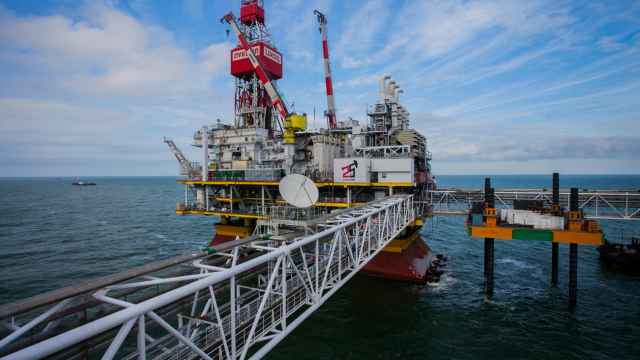Russian authorities are bracing for a continued slump in oil prices, with the Economic Development Ministry significantly reducing its 2025 forecast for the average price of Urals crude to $56 per barrel.
That would mark the lowest level since 2020, when the Covid-19 pandemic triggered a collapse in global demand and pushed Urals to an annual average of $41.70 per barrel. Before that, prices had dipped below $56 only in 2015 and 2016, when Urals averaged $51.20 and $41.90, respectively.
The new forecast falls well below the $69.70 per barrel price baked into Russia’s federal budget, and even below the cut-off price of $60.
Under the country’s fiscal rules, any oil and gas revenues earned above that threshold are funneled into the National Wealth Fund (NWF), while revenues below the cut-off must be covered by drawing from the fund. As of April 1, the NWF held 3.27 trillion rubles ($39.8 billion) in liquid assets.
The decline in oil prices comes amid a global economic slowdown and rising fears of a recession, spurred in part by a trade war initiated by the U.S. Brent crude recently fell below $60 per barrel, while Urals dipped under $50. In the first quarter of 2025, oil and gas revenues to the federal budget dropped 10% year over year, with a 17% plunge in March alone.
Each $1 drop in the price of oil costs the Russian budget roughly 160 billion rubles ($1.9 billion) in annual lost revenue, according to investment banker Yevgeny Kogan.
Analysts at Raiffeisenbank estimate that if the average price of oil slips to $55 for the year, the resulting shortfall — covered through foreign currency sales from the NWF — would amount to 900 billion rubles ($10.9 billion).
A $10 drop in the price of Russian crude from $65 to $55 per barrel could reduce GDP growth by at least 0.5 percentage points and wipe out roughly 1 trillion rubles ($12.2 billion) in budget revenue, said Sofia Donets, chief economist at T-Investments.
The Economic Development Ministry also revised its exchange rate forecast due to the ruble’s unexpected rally since January. The average annual exchange rate against the U.S. dollar is now projected at 94.3, down from the previous estimate of 96.5. By year’s end, the exchange rate is expected to hit 98.7.
Because oil and gas taxes are denominated in dollars, a stronger ruble reduces their value in ruble terms — adding further strain on the federal budget.
Under these conditions, the budget deficit in 2025 could exceed the Finance Ministry’s plan by 2 to 2.5 trillion rubles ($24.3 billion-$30.4 billion) due to the loss of oil and gas revenue, analysts at the think tank Tverdye Tsifry estimate.
Some of the shortfall may be offset by other income sources. The Economic Development Ministry raised its inflation forecast from 4.5% to 7.6%, but kept its economic growth projection steady at 2.5% for the year. Higher nominal GDP could help bolster non-oil revenue, analysts from Tverdye Tsifr said.
Officials point to a relatively strong start to the year as justification for maintaining their current GDP growth outlook.
“We consider this estimate to be quite realistic,” the ministry said, according to Interfax. “The economy is gradually slowing, but we don’t expect a sharp downturn. To hit 1.5% growth for all of 2025, a technical recession would need to occur in one quarter — but we’re not factoring that into our baseline scenario.”
Additional non-oil revenues are likely to be spent, as Russia’s budget rule allows the Finance Ministry to use such funds for expenditures.
Alexander Isakov, an economist with Bloomberg Economics, expects the government to increase its spending plan by 1 to 1.2 trillion rubles ($12.2 billion-$14.6 billion), driven by higher debt servicing costs and stronger-than-expected non-oil revenues.
Still, Donets warns that the oil revenue shortfall is particularly painful given the significant drawdown of the NWF and inflexibility in defense spending.
This year’s budget calls for a deficit of 1.2 trillion rubles ($14.6 billion), or 0.5% of GDP.
Deputy Finance Minister Vladimir Kolychev said that if oil prices hover closer to $60, the deficit will be “somewhat larger,” but likely not exceed 1% of GDP — or roughly 2 trillion rubles ($24.3 billion). Yet in the first three months of the year, the federal deficit had already reached 2.2 trillion rubles ($26.8 billion).
Looking ahead, the Economic Development Ministry forecasts only a modest recovery in oil prices: Urals is expected to average $61 per barrel in 2026, rising to $63 in 2027 and $65 in 2028.
A Message from The Moscow Times:
Dear readers,
We are facing unprecedented challenges. Russia's Prosecutor General's Office has designated The Moscow Times as an "undesirable" organization, criminalizing our work and putting our staff at risk of prosecution. This follows our earlier unjust labeling as a "foreign agent."
These actions are direct attempts to silence independent journalism in Russia. The authorities claim our work "discredits the decisions of the Russian leadership." We see things differently: we strive to provide accurate, unbiased reporting on Russia.
We, the journalists of The Moscow Times, refuse to be silenced. But to continue our work, we need your help.
Your support, no matter how small, makes a world of difference. If you can, please support us monthly starting from just $2. It's quick to set up, and every contribution makes a significant impact.
By supporting The Moscow Times, you're defending open, independent journalism in the face of repression. Thank you for standing with us.
Remind me later.






